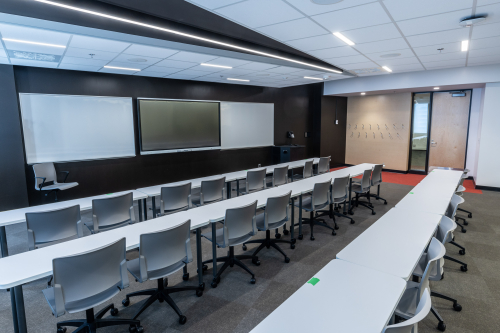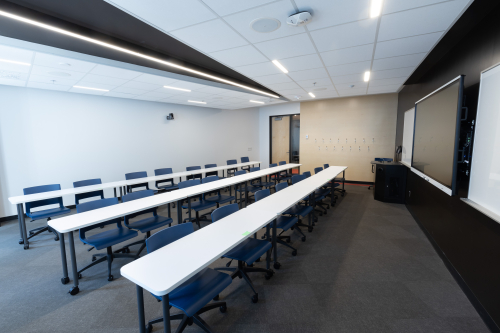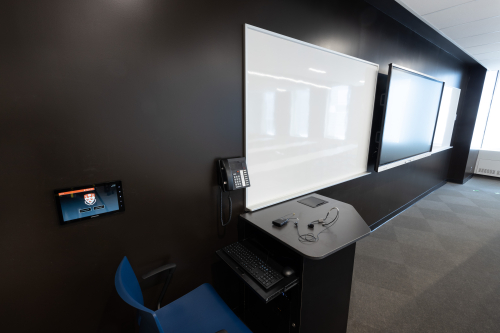- Location: 3655 Promenade Sir William Osler, Montreal, QC
- Capacity: Two rooms for 24 students
- Type: Flat classroom
Alignment with principles for designing Teaching and Learning Spaces
Academic challenge
Promote individual, active engagement with content.
Layout
Students can work individually, in pairs, or in teams at movable rectangular tables. Each table has ample work surfaces for classroom materials (e.g., notebooks, laptops, and textbooks).
Furniture
Comfortable, adjustable, ergonomically approved chairs with wheels permit rapid transitions between individual and group learning activities.
Technologies
Access to resources: SMART board with multiple connection types (e.g., HDMI, wireless) to display learning materials. Web-conferencing capabilities allow for interaction with remote participants.
Lighting & colour
Natural and overhead lighting permits individual work. Blue accents brighten the room.

Learning with peers
Promote active engagement with one another.
Layout
Tables can be moved to accommodate group work, in groups of up to four students. Students are able to easily circulate in the classroom due to sufficient passing space between tables.
Acoustics: Sound zones support multiple simultaneous conversations among students.
Furniture
The table layout permits collaborative approaches to coursework, and improved communication (both verbally and line-of-sight). Armless chairs allow students to easily turn and discuss in pairs or small groups, supporting collaborative learning.
Technologies
Large whiteboards situated at the front of the classroom facilitate group work.
Lighting & colour
Different lighting patterns and levels support different learning activities.

Experiences with faculty
Promote interaction and communication.
Layout
Instructor has a small podium to store equipment and ample space to lecture at the front of the class, using the SMART board or the whiteboards. The instructor has access to all students due to a layout that permits ample passing space, and clear sightlines.
Acoustics: Sounds zones ensure that not only are students able to hear the instructor, but that the instructor is also able to hear the students.
Furniture
Tables are easily accessible and have sufficient space surrounding them for the instructor to check in with a given group. Mobile chairs support different teaching strategies.
Technologies
The SMART board permits display of learning materials and is loaded with an interactive whiteboard application. Web-conferencing capabilities allow the instructor to integrate remote participants.
Lighting & colour
Lighting patterns provide a bright, pleasant environment and support multiple types of teaching and learning tasks.

Contributions to the campus environment
Classrooms that incorporate elements of active and collaborative learning are part of a vision for a variety of flexible campus learning spaces. This room is designed for all populations using the space: well-lit, with a standardized room control panel that simplifies instructors’ use of equipment in classrooms across campus. IT is consistent with teaching and learning needs, and durable furniture contributes to sustainability efforts. Both physical and virtual affordances help maximize High Impact Practices (HIPs) for student learning within and beyond this classroom.
